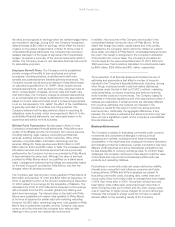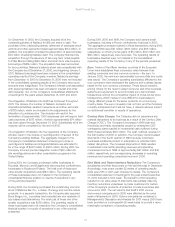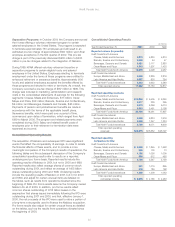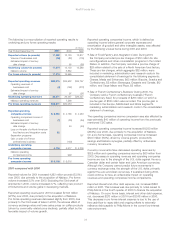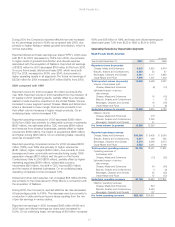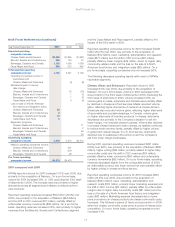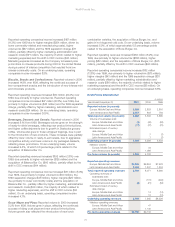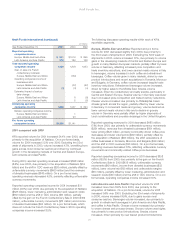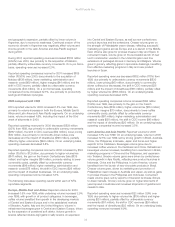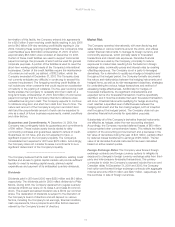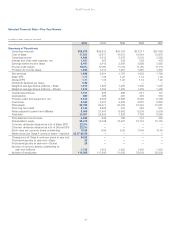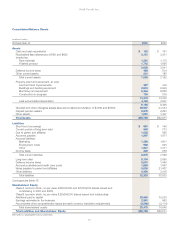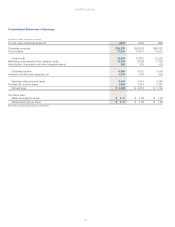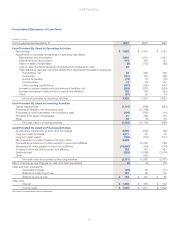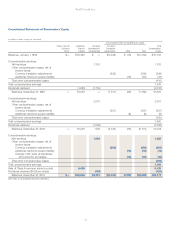Kraft 2001 Annual Report Download - page 38
Download and view the complete annual report
Please find page 38 of the 2001 Kraft annual report below. You can navigate through the pages in the report by either clicking on the pages listed below, or by using the keyword search tool below to find specific information within the annual report.
Kraft Foods Inc.
32
and geographic expansion, partially offset by lower volume in
Argentina, due to economic weakness. Continued erosion of the
economic climate in Argentina may negatively affect volume and
income growth in the Latin America and Asia Pacific segment
during 2002.
During 2001, reported operating revenues increased $1,183 million
(94.9%) over 2000, due primarily to the acquisition of Nabisco,
partially offset by unfavorable currency movements. On a pro forma
basis, operating revenues increased 2.0%.
Reported operating companies income for 2001 increased $189
million (100.0%) over 2000, due primarily to the acquisition of
Nabisco ($128 million), lower marketing, administration and
research costs ($69 million), higher margins ($14 million) and the
shift in CDC income, partially offset by unfavorable currency
movements ($32 million). On a pro forma basis, operating
companies income increased 32.7%, due primarily to productivity
savings and Nabisco synergies.
2000 compared with 1999
KFI’s reported volume for 2000 increased 1.5% over 1999, due
primarily to volume increases in both the Europe, Middle East &
Africa and Latin America & Asia Pacific segments. On an underlying
basis, volume increased 4.9%, including the impact of the 53rd
week of shipments in 2000.
Reported operating revenues for 2000 decreased $829 million
(9.3%) from 1999, due primarily to unfavorable currency movements
($887 million), the shift in CDC revenues ($52 million), lower pricing
($30 million, due primarily to commodity-driven coffee price
decreases) and the impact of divestitures ($196 million), partially
offset by higher volume/mix ($291 million). On an underlying basis,
operating revenues decreased 6.8%.
Reported operating companies income for 2000 increased by $145
million (13.6%) to $1.2 billion, due primarily to higher volume/mix
($147 million), the gain on the French Confectionery Sale ($139
million) and higher margins ($84 million, primarily relating to lower
commodity costs), partially offset by unfavorable currency
movements ($96 million), higher marketing, administration and
research costs ($78 million), the shift in CDC income ($26 million)
and the impact of divested businesses. On an underlying basis,
operating companies income increased 5.3%.
The following discusses operating results within each of KFI’s
reportable segments.
Europe, Middle East and Africa: Reported volume for 2000
increased 0.5% over 1999, while underlying volume increased 2.9%
over 1999, with growth in all product categories. In beverages,
coffee volume benefited from growth in the developing markets
of Central and Eastern Europe and in the established markets
of Sweden, Austria, Italy and the United Kingdom. Volume in
refreshment beverages grew in Central and Eastern Europe, driven
by the expansion of powdered soft drinks. Volume growth in
snacks reflected double-digit gains in salty snacks on expansion
into Central and Eastern Europe, as well as new confectionery
product launches and line extensions. Cheese volume grew on
the strength of Philadelphia cream cheese, reflecting successful
marketing programs across Europe and a re-launch in the Middle
East. Volume also grew for process cheese in Italy and Spain. In
convenient meals, volume grew on the successful launch of new
lunch combination varieties in the United Kingdom and line
extensions of packaged dinners in Germany and Belgium. Volume
grew in grocery, reflecting gains in spoonable dressings, benefiting
from effective marketing programs in Italy and new product
launches in Spain.
Reported operating revenues decreased $852 million (11.1%) from
1999, due primarily to unfavorable currency movements ($830
million), lower pricing ($60 million, due primarily to commodity-
driven coffee price decreases), the shift in CDC revenues ($28
million) and the impact of divestitures ($163 million), partially offset
by higher volume/mix ($186 million). On an underlying basis,
operating revenues decreased 9.0%.
Reported operating companies income increased $124 million
(13.9%) over 1999, due primarily to the gain on the French
Confectionery Sale ($139 million), higher volume/mix ($104 million)
and higher margins ($70 million, due primarily to lower coffee
commodity costs), partially offset by unfavorable currency
movements ($97 million), higher marketing, administration and
research costs ($58 million), the shift in CDC income ($16 million)
and the impact of divestitures ($20 million). On an underlying basis,
operating companies income increased 2.5%.
Latin America and Asia Pacific: Reported volume for 2000
increased 5.1% over 1999. On an underlying basis, volume in 2000
increased 12.5% over 1999, led by strong growth in Brazil, Australia,
China, the Philippines, Indonesia, Japan and Korea and higher
exports to the Caribbean. Beverages volume grew due to
increased coffee volume in the Caribbean and China. Refreshment
beverages volume increased, benefiting from new flavors in Brazil,
marketing programs in China and the Philippines, and expansion
into Thailand. Snacks volume gains were driven by confectionery
volume growth in Asia Pacific, reflecting new product launches in
Indonesia, China and the Philippines. In Latin America, volume
benefited from the launch of new chocolate products in Brazil.
Cheese volume grew, driven by marketing and promotion of
Philadelphia cream cheese in Australia and Japan, as well as gains
in process cheese in the Philippines and Indonesia. Convenient
meals volume grew, led by exports of macaroni & cheese dinners
to Asian markets. Grocery volume grew on higher shipments of
yeast spread in Australia and increased shipments of gelatins and
cereals to Asia.
Reported operating revenues increased $23 million (1.9%) over
1999, due primarily to higher volume/mix ($105 million) and higher
pricing ($30 million), partially offset by unfavorable currency
movements ($57 million), the shift in CDC revenues ($24 million)
and the impact of divestitures ($33 million). On an underlying basis,
operating revenues increased 6.9%.



